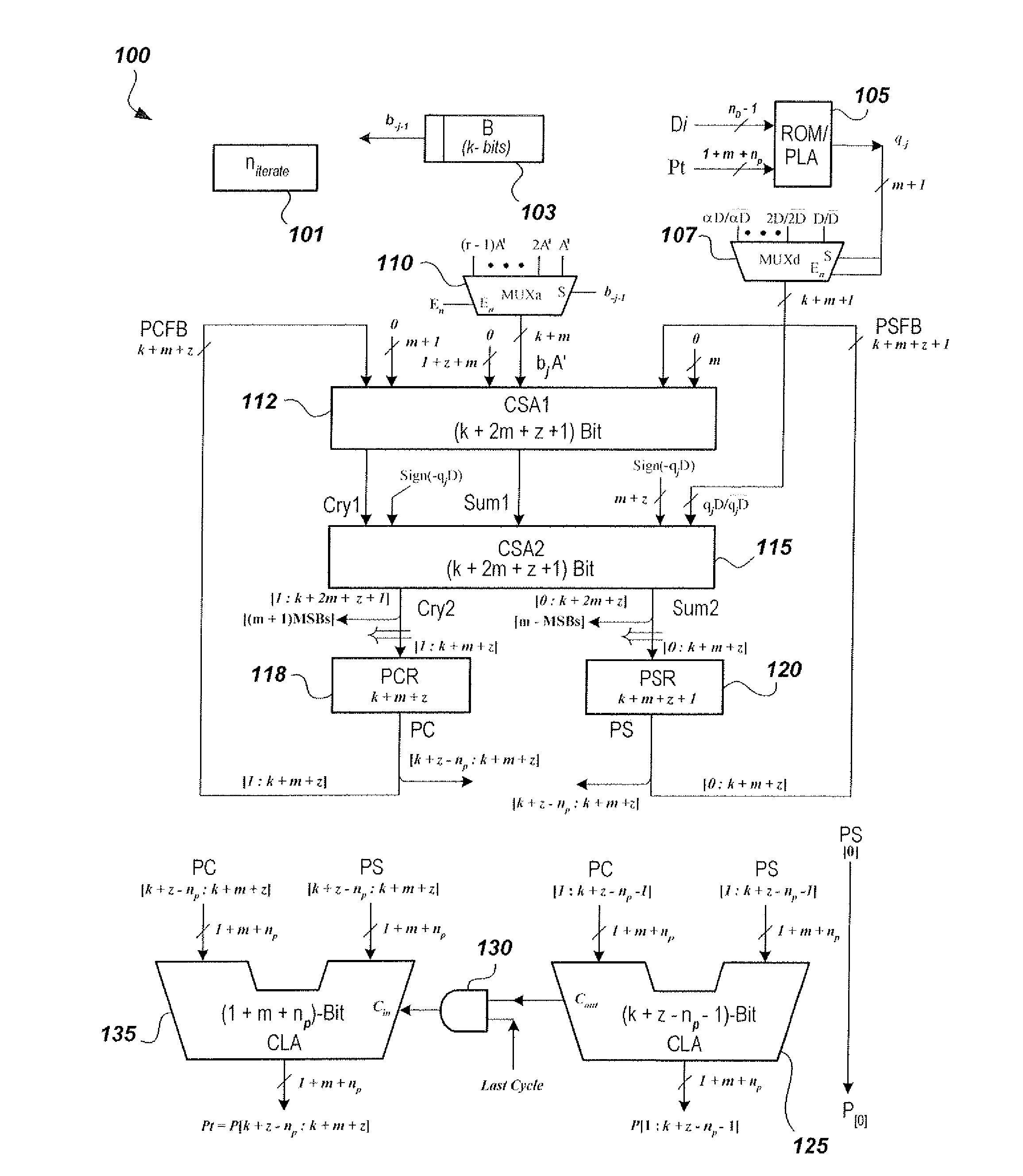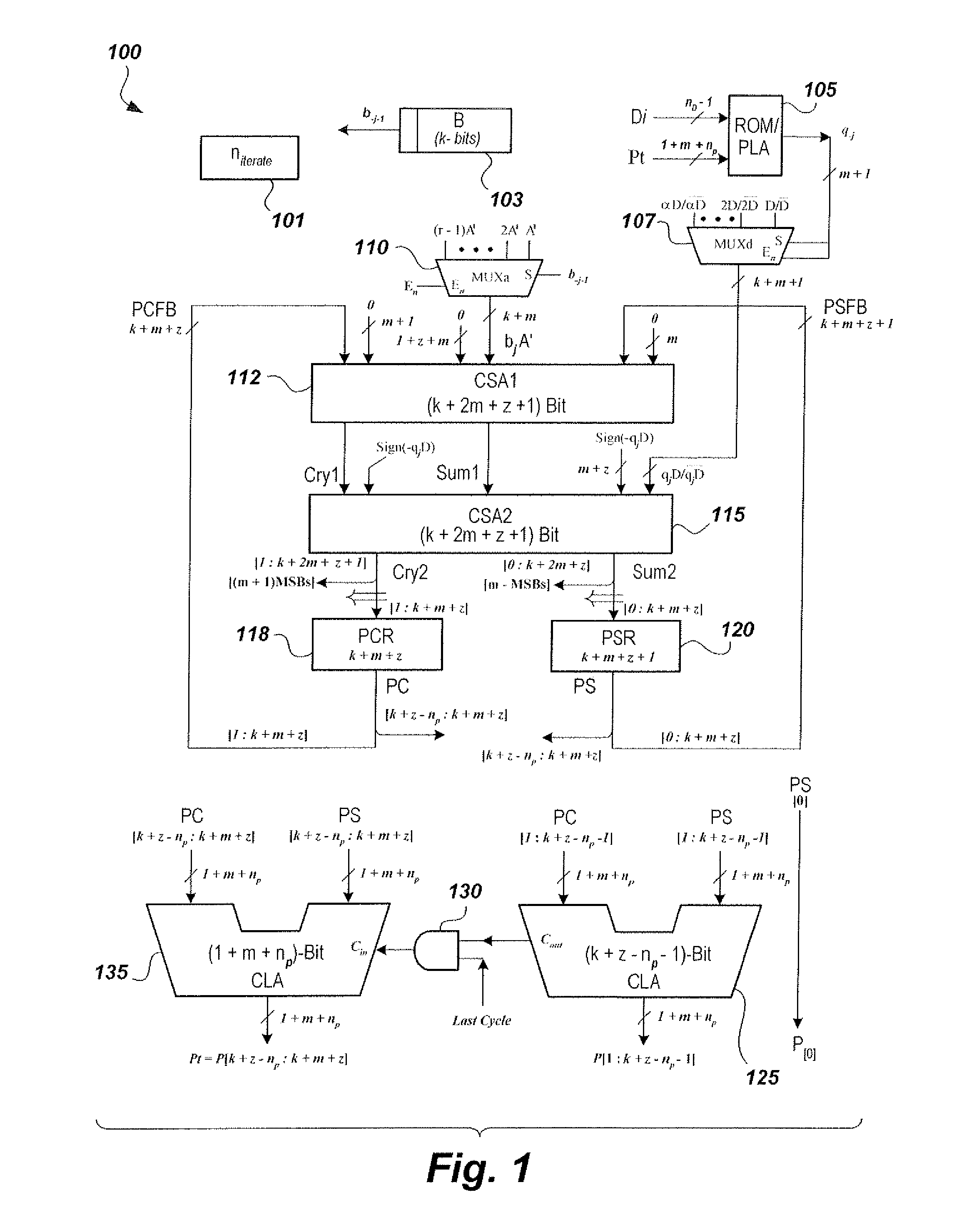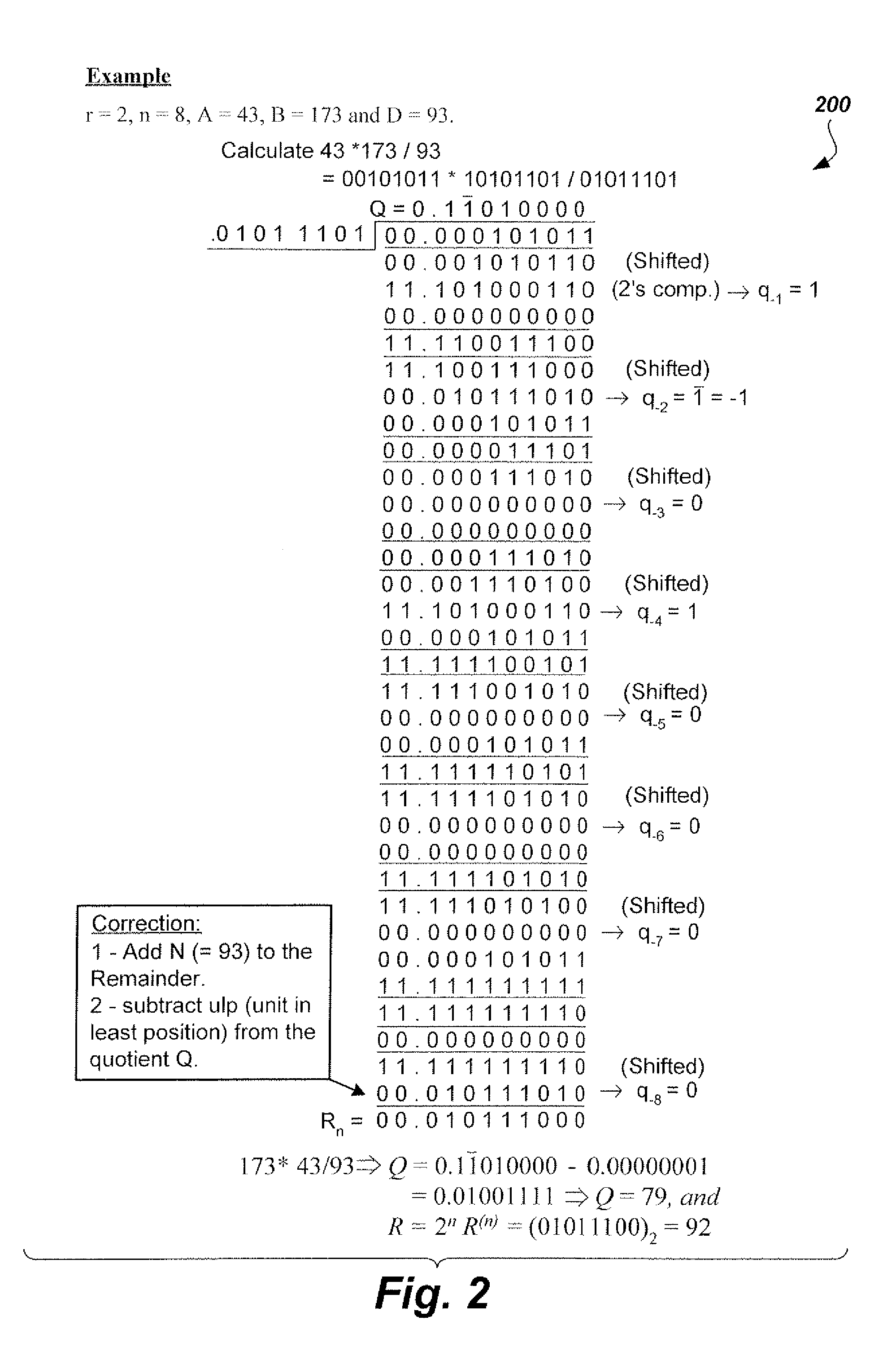High-radix multiplier-divider
a multiplier and high-radix technology, applied in the field of high-performance digital arithmetic circuitry, can solve the problems of corresponding increase in complexity and hardware, low complexity of digit recurrence algorithm implementation, and large area utilization
- Summary
- Abstract
- Description
- Claims
- Application Information
AI Technical Summary
Benefits of technology
Problems solved by technology
Method used
Image
Examples
example 1
[0145]If Carry-Propagate Adders (CPA) are used, compute AB / D=(0.1110—1001)*(0.10011100) / (0.1101—1110) using radix r=4, and Dmin=0.5. Let A′=0.1110—1001, B=0.10011100, and D=0.1101—1110.
[0146]h=⅔=0.667, nP(Low_Bound)=3, nD(Low_Bound)=3, Z1=5, Z2 computed at [nD(Low_Bound)+1] is 4. Thus, Z=Max(Z1, Z2)=5, ωmax=2−4=0.0625,
nP(min)=⌈Log21(2h-1-ωmax)Dmin⌉=3andnD(min)=⌈Log2{(α-h+ωmax)(2h-1-ωmax)Dmin}⌉=4.
[0147]Considering the worst case of D=Dmin=0.5, and computing Lk and Uk−1 at various values of k, it can be shown that no solution is possible for nP=3 and nD=4. However, a solution exists for the case of nP=3 and nD=5. The table below lists the values of Lk and Uk−1 for various values of k at D=Dmin=0.5, in addition to possible values of the comparison constants mk for this case.
TABLE VLk, Uk−1, and mk for D = Dmin = 0.5kLkUk−1mk−1−0.83333−0.74154−0.750−0.33333−0.21029−0.2510.1770830.3020830.2520.7083330.8020830.75
[0148]For the example at hand since nD=5, the truncated value of D is given b...
example 2
[0154]Using Carry-Save Adders (CSA), compute AB / D=(0.1110—1001)*(0.10011100) / (0.1101—1110) using radix r=4, Dmin=0.5.
[0155]Let A′=0.1110—1001, B=0.10011100, and D=0.1101—1110. h=⅔=0.667, nP(Low_Bound)=3, nD(Low_Bound)=4, Z1=5, Z2=4. Thus,
Z=Max(Z1,Z2)=5,ωmax=2-4=.0625,nP(min)=⌈Log21(2h-1-ωmax)Dmin⌉=3,andnD(min)=⌈Log2(α-h+ωmax)(2h-1-ωmax)Dmin⌉=4.
[0156]Considering the worst case of D=Dmin=0.5, and computing Lk and Uk−1 at various values of k, it can be shown that no solution is possible for np=3 and nD=4. However, a solution exists for the case of np=4 and nD=6. Table X below lists the values of Lk and Uk−1 for various values of k at D=Dmin=0.5, in addition to possible values of the comparison constants mk for this case.
TABLE XLk, Uk−1, and mk for nP = 4 and nD = 6kLkUk−1mk(0.5)−1−0.83333−0.78223−0.81250−0.33333−0.2666−0.312510.1718750.2395830.187520.68750.7395830.6875
[0157]For the example at hand since nD=6, the truncated value of D is given by Dt=0.110111=55 / 64. Table XI gives the co...
example 3
[0161]Compute AB / D=(1.110—1001)*(1.001—1100) / (1.101—1110) using radix r=4, Dmin=1.0 and Carry-Save Adders.
[0162]Let A′=1.110—1001, B=1.001—1100 and
D=1.101_1110=194128=1.734375.
h=⅔=0.667, nP(Low_Bound)=2, nD(Low_Bound)=3, Z1=5, Z2=4, Z=Max(Z1, Z2)=5, ωmax=2−4=0.0625.
[0163]Considering the worst case of D=Dmin=1.0, and computing Lk and Uk−1 at various values of k, it can be shown that a solution exists for the case of np=3 and nD=5. Table XII below lists the values of Lk and Uk−1 for various values of k at D=Dmin=1.0, in addition to possible values of the comparison constants mk for this case.
TABLE XIILk, Uk−1, and mk for D = Dmin = 1.0kLkUk−1mk−1−1.66667−1.56445−1.6250−0.66667−0.5332−0.62510.343750.4791670.37521.3751.4791671.375
[0164]For the example at hand, since nD=5, the truncated value of D is given by Dt=1.1011=1 11 / 16. Table XIII gives the computed values of Lk and Uk−1 for various values of k, together with the selected values of comparison constants for the range
D=11116:11216....
PUM
 Login to View More
Login to View More Abstract
Description
Claims
Application Information
 Login to View More
Login to View More - R&D
- Intellectual Property
- Life Sciences
- Materials
- Tech Scout
- Unparalleled Data Quality
- Higher Quality Content
- 60% Fewer Hallucinations
Browse by: Latest US Patents, China's latest patents, Technical Efficacy Thesaurus, Application Domain, Technology Topic, Popular Technical Reports.
© 2025 PatSnap. All rights reserved.Legal|Privacy policy|Modern Slavery Act Transparency Statement|Sitemap|About US| Contact US: help@patsnap.com



